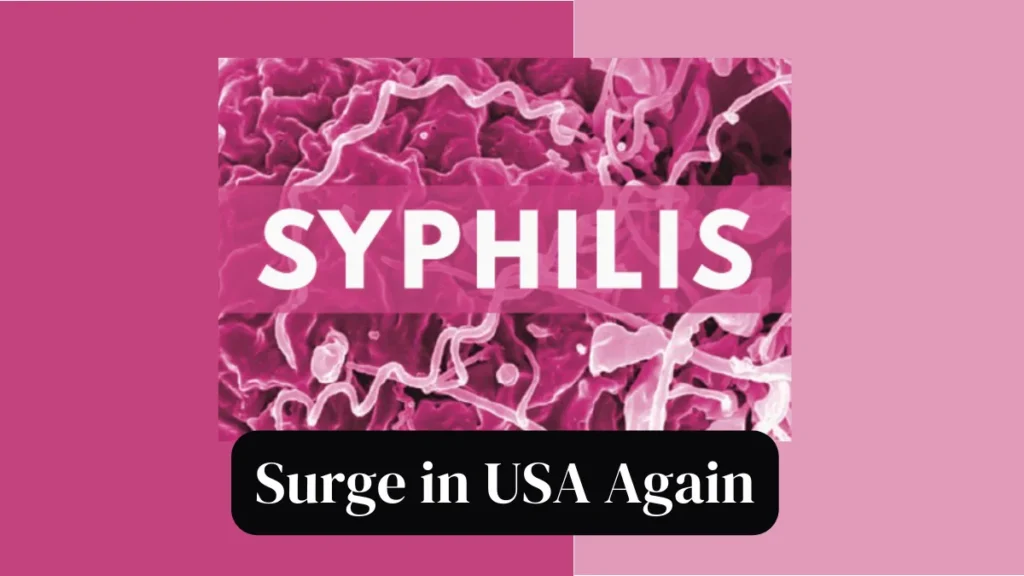Syphilis Surge in the U.S: Unlocking the Syphilis Surge: Delving into Causes, Confronting Challenges, and Crafting Solutions in the U.S.
Syphilis Surge in the U.S
Syphilis, a sexually transmitted infection (STI) once on the brink of elimination, has made a concerning resurgence in the United States in recent years. This review article delves into the factors contributing to this surge and the challenges faced by public health officials in addressing this issue. From stagnant funding to increased circulation among marginalized populations, from disruptions caused by the COVID-19 pandemic to the shortage of penicillin, each aspect plays a crucial role in shaping the current landscape of syphilis prevalence in the U.S. Additionally, efforts to address the surge in syphilis cases and potential solutions to mitigate its spread in the future will be discussed.

Stagnant Funding:
Stagnant funding has been a significant obstacle in the fight against syphilis. Despite the availability of effective prevention and treatment measures, funding for syphilis control programs has not kept pace with the growing need. This lack of financial resources has led to a shortage of personnel, limited access to testing and treatment services, and inadequate public awareness campaigns. As a result, the ability of public health officials to effectively combat the surge in syphilis cases has been severely hampered.
Increased Circulation Among Marginalized Populations:
Syphilis has disproportionately affected marginalized populations, including cisgender heterosexual individuals and communities of color. Factors such as limited access to healthcare services, socioeconomic disparities, and stigma surrounding sexual health discussions have contributed to the increased circulation of syphilis within these communities. Addressing the underlying social determinants of health and implementing targeted outreach and education initiatives are essential to addressing this disparity and reducing the burden of syphilis among marginalized populations.
Lack of Testing:
A critical challenge in addressing the surge in syphilis cases is the lack of sufficient testing infrastructure. Despite the availability of effective diagnostic tools, testing rates for syphilis remain low, particularly among high-risk populations such as pregnant women. This deficiency in testing infrastructure leads to undiagnosed cases and missed opportunities for early intervention and treatment, ultimately fueling the spread of syphilis within the population. Strengthening syphilis testing programs and expanding access to testing services are crucial steps in addressing this challenge.
Disruption Due to COVID-19:
The COVID-19 pandemic has further exacerbated the challenges in addressing the syphilis epidemic. Disruptions to healthcare services, closures of clinics, and reassignment of staff to COVID-19 response efforts have led to a decrease in routine testing and surveillance activities. This has resulted in underdiagnosis and delayed treatment of syphilis cases, allowing the infection to spread unchecked. As the healthcare system continues to recover from the impact of the pandemic, efforts to restore and strengthen syphilis testing and surveillance programs are essential to addressing this challenge.
Reduction in Funding for STI Screening and Prevention:
Congressional cuts to funding for STI screening and prevention programs have also hindered efforts to address the surge in syphilis cases. The reduction in funding has strained the capacity of public health departments to conduct outreach, provide testing services, and implement effective prevention strategies. This has resulted in gaps in syphilis prevention efforts and limited access to essential healthcare services for at-risk populations. Advocating for increased funding and resources for STI screening and prevention programs is essential to addressing this challenge and reducing the burden of syphilis in the United States.
Shortage of Penicillin:
The shortage of benzathine penicillin, the primary medication used to treat syphilis, poses a significant challenge to the management of syphilis cases, especially in pregnant women. This shortage has necessitated the prioritization of treatment for pregnant individuals and the exploration of alternative antibiotics, adding complexity to the already challenging landscape of syphilis control efforts. Efforts to address the shortage of penicillin and ensure access to effective treatment options for syphilis are critical to reducing the burden of the disease and preventing its complications.
Efforts to Address the Surge in Syphilis Cases:
Despite the challenges outlined above, efforts are underway to address the surge in syphilis cases and mitigate its spread in the future. These efforts include:
- Enhanced funding and resources for syphilis prevention and control programs.
- Targeted outreach and education initiatives to raise awareness about syphilis prevention, testing, and treatment.
- Strengthening syphilis testing and surveillance programs to improve early detection and intervention.
- Addressing the underlying social determinants of health that contribute to syphilis disparities.
- Advocating for policies that support access to affordable and equitable healthcare services for all individuals, including those at risk of syphilis.
Potential Solutions to Mitigate the Spread of Syphilis:
In addition to ongoing efforts, several potential solutions could help mitigate the spread of syphilis in the future. These include:
- Expanding access to syphilis testing and treatment services, particularly in underserved communities.
- Implementing comprehensive sexual health education programs to promote safer sexual practices and increase awareness about syphilis and other STIs.
- Enhancing provider education and training on syphilis diagnosis and management to improve clinical outcomes.
- Investing in research and development of new diagnostic tools and treatment modalities for syphilis.
- Collaborating with community-based organizations and stakeholders to develop culturally competent and inclusive syphilis prevention and control initiatives.
Final Thoughts:
The surge in syphilis cases in the United States presents a complex and multifaceted public health challenge that requires a comprehensive and collaborative approach to address effectively. By addressing the underlying factors contributing to the surge in cases, strengthening syphilis prevention and control efforts, and advocating for increased funding and resources, we can work towards reducing the burden of syphilis and improving sexual health outcomes for all individuals in the United States. Together, we can make strides towards a future where syphilis is no longer a public health threat.
Visit USAExpressvibes.com for the Latest News, Reviews, Entertainment insights and more Updates. Follow us on Telegram and Facebook as well to ensure you never miss a beat!








